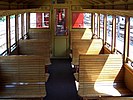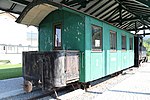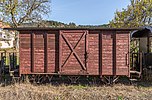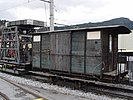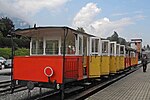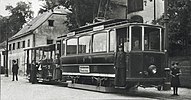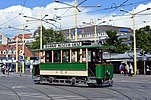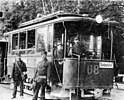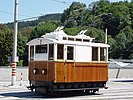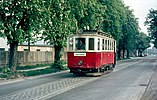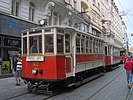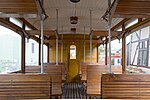Grazer Maschinen- und Waggonbau-Aktiengesellschaft


The Grazer Maschinen- und Waggonbau-Aktiengesellschaft (formerly Johann Weitzer or often simply referred to as Graz ) was an Austrian mechanical engineering and vehicle company from Graz .
history
The beginnings and the rise
In 1854, the son of a weaver Johann Weitzer (1832–1902) from Friedberg , who had been an apprentice to a blacksmith and cart smith, founded a company in his name in Graz together with three journeymen. From 1857 this blacksmith, locksmith, joiner's and house painter's workshop for the manufacture of wagons resided in a former cadet school . In 1861 Weitzer built a new factory with an attached foundry under the name Wagen- und Waggonfabrik, Eisen- und Metallgießerei Joh. Weitzer . In the same year, freight and passenger cars were delivered to the Graz-Köflacher Railway , and Weitzer soon also delivered vehicles for the construction of the Suez Canal . In the war year 1866 , the company built large wagons and carriages for the Austro-Hungarian army and also supplied 50,000 Remington rifles. This made Weitzer the first supplier of breech loading rifles in Austria. After the defeat in 1866, the company produced 100,000 so-called Wänzl rifles for the army. In 1872 the company is converted into a public limited company. The name changes to Grazer Waggon- & Maschinen-Fabriks-Aktiengesellschaft vorm. Joh. Weitzer . The company was also active in mechanical engineering: At the Vienna World Exhibition in 1873 , steam boilers manufactured by Weitzer were shown in addition to wagons, and in the same year a steam engine was delivered to Radwerk III in Vordernberg .
From the early 1890s the factory was a specialized main supplier of all types of narrow-gauge vehicles and electric multiple units for narrow-gauge and standard-gauge. In 1895, the company was re-established as a stock corporation with the participation of Weitzer, Karl Neufeld and Schoeller & Co. and incorporated into the Schoeller Group; the company headquarters relocated to Vienna.
Technical innovation through diesel engines
Graz was the first and largest producer of diesel engines in what was then Austria; the construction of diesel engines based on patents from Rudolf Diesel and licenses from MAN began as early as 1899 . They were mainly used to drive factories and to generate electricity; during World War I even two dynamo machines were delivered to a radio station of the Austro-Hungarian Navy in Pola. In 1926 the 1000th diesel engine was delivered. In the spring of 1930, the diesel engine division of the traditional Leobersdorfer machine factory, which had been hit by the global economic crisis, was taken over . According to an advertisement in 1933, the company supplied engines with outputs between 8 and 3000 hp. The emergency power generators of the former Bisamberg transmitter (1933) , which still exist today, come from the Grazer Maschinen- und Waggonbau-Aktiengesellschaft. The first motor ship on Lake Constance , the MS Oesterreich , also ran with Graz diesel engines from its launch in 1928 until the 1960s.
After electric locomotives were also built in smaller numbers from the 1910s, attempts were made at the end of the 1920s to build diesel locomotives and gasoline-mechanical railcars based on DWK's own designs and licenses .
Upswing despite the crisis
Before and during the First World War, the company was highly profitable, 808,660 kroner of net profit was earned in 1912 alone, and a dividend of 11% was paid out (in 1911 it was 10%). The First World War was excellent business for the Grazer Waggon- und Maschinenfabrik: in 1916, for example, they earned 1,256,049 kroner and in 1917 already 1,561,244 kroner, a dividend of 12% (48 kroner) was paid out. It was decided to increase the capital from one million to a share capital of five million crowns. The number of employees reached a new high at this time with 300 employees and over 4000 workers (in 1914 it was "only" 1300). The company also served the armaments industry, producing around 60,000 shrapnel casings per month on behalf of the Army Administration and also manufacturing large numbers of mine-throwing tubes and axles for field howitzers. Diesel engines for the diesel-electric drives of the SM submarines were manufactured for the kuk Marine . Among other things, Graz equipped the SM U 14 captured by Austria, the former French Curie , with specially redesigned six-cylinder engines with 420 hp each.
Thanks to its established position, the company coped with the collapse of the Austro-Hungarian monarchy and with it the loss of its traditional sales areas. At first they managed to repair railway wagons for the Southern Railway Company and the newly established Yugoslav State Railways , but orders from Bulgaria and Turkey were soon won. In 1927 a documentary film was even shown in the Graz cinemas, which showed the work and its high-quality products in detail to the until then mostly ignorant audience.
The work
In 1931, the factory in Graz covered an area of 130,000 m 2 , of which around 53,000 m 2 were built-up. The wood storage area alone was approx. 50,000 m 2 in size. The wood required for the wagon construction at that time, such as wood, was stored and dried here. B. local hard and soft woods, mahogany , pitch pine or cedar . The plant included a wood drying plant , wood processing (at that time the largest and most modern in Austria, already converted to assembly line work), furthermore the forge, boiler shop (for tank wagons and the like), halls for underframe and box construction , the locksmith's shop, and finally the assembly hall and painting department. Here the finished car bodies were provided with the outer sheets, roof, floors and interior fittings, and the paint was already being painted with the spray gun . The steam with a pressure of 10 atmospheres for operating the forging hammers came from an automatically fired boiler system with a grate area of 1150 m 2 . The electricity was generated in its own power plant with diesel engines with a total of 2500 HP, and electricity was also drawn from the public grid. A large compressor system generated the compressed air required for riveting machines and painting. The halls for the construction of underframes and car bodies were not rebuilt until the end of the 1920s. At full capacity, up to 4000 wagons could be produced annually.
Peak and crisis, decline and resurrection
In 1928 and 1929 the number of employees reached a new high. Due to the economic crisis of the early 1930s and the resulting decline in production, the company came under the influence of the Simmeringer Waggonfabrik , with which there had been closer relationships since the early 1920s: In 1921, a community of interests was formed with Simmeringer , which was primarily based on quota Allocation of supplies for export served. A wagon building cartel was formed beforehand with other factories. In 1931 the factory in Graz was still considered "surprisingly busy". After that it seemed to be going downhill and the number of orders decreased. 1934 was a difficult year for the company: as a result of the restructuring of the ailing company, Simmeringer Maschinen- und Waggonbau-Aktiengesellschaft took over the majority of the shares. The entire production and diesel engine production were then moved to Simmering, only the forge was still in operation. Only 250 workers remained that year. In 1935 the foundry was closed.
In the course of the annexation of Austria to the German Reich, Adolf Hitler gave a speech on April 3, 1938 in the empty halls of the Grazer Waggonfabrik. Operations at the plant were resumed in autumn of this year. Major orders from the Deutsche Reichsbahn resulted in a workforce of 600.
The company last traded under the name Grazer Maschinen- und Waggonbau-Aktiengesellschaft from 1939 , before it merged with Paukerwerk Aktiengesellschaft and Simmeringer Maschinen- und Waggonbau-Aktiengesellschaft , both of which were based in Vienna , to form the new Simmering-Graz-Pauker Aktiengesellschaft für Maschinen- , Boiler and wagon construction was merged. The new company was owned by the Reichswerke Hermann Göring and, like many other companies, served the construction of armaments. Large series of freight cars, tank wagons and tenders for the Reichsbahn were built in Graz, but also guns, mine throwers, ammunition and torpedoes for the Wehrmacht and Navy were produced. During the war years, up to 1,600 workers were employed in the Graz plant. Between November 1944 and April 1945, the Graz wagon factory was almost completely destroyed in the course of bombardments, and 110 direct hits were counted on the factory premises. After the end of the war, operations were quickly rebuilt, from then on Graz was the location for the production of electric locomotives, wagons and railcars for the SGP group nationalized in 1946 . Diesel locomotives and multiple units as well as trams were manufactured in Simmering from then on. The traditional location still exists today under the name Siemens AG Austria and manufactures bogies and pantographs for locomotives, railcars and wagons.
In 1891 Johann Weitzer also created a second pillar for himself with Weitzer János Gép, - Waggongyár és Vasöntöde Részvénytársaság in Arad , which is located in the Hungarian half of the country , which is now part of Romania . This company also still exists today under the name Astra Vagoane Călători . This independent subsidiary of the Graz plant also built steam locomotives and gained experience in the construction of combustion railcars at an early stage: it was already building the now well-known gasoline-electric Weitzer-De Dion-Bouton railcars for the Hungarian railways before 1910 .
Products
Electric traction vehicles
The Grazer Waggonfabrik was a leader in the construction of electric railcars from the start and supplied the original rolling stock for a large part of the trams in what is now Austria, such as the operations in Vienna , Graz , Linz , Innsbruck , Salzburg , Klagenfurt , St. Pölten and Gmunden . Electric local railways such as the Linzer Lokalbahn , Florianerbahn , the Innsbrucker Mittelgebirgsbahn , the Übelbacher Bahn , the Stubaitalbahn , the Vorchdorferbahn , the Haager Lies , the Höllentalbahn Payerbach-Hirschwang and the Gleichenberger Bahn received electric railcars from Graz to start operations. In 1927 Graz delivered the elegantly furnished "Schnellbahn-Motorwagen" of the 220 series to the Wiener Lokalbahnen . Graz mostly worked here as a subcontractor for the electrical companies ÖSSW , AEG-Union , ELIN and the Austrian Brown, Boveri-Werke and manufactured the mechanical part of the car.
While smaller, technically based on multiple units electric locomotives were already being built in the early years, the Ewp series of the Pressburgerbahn (later ÖBB 1072 ) were built in Graz in 1914. The company also supplied numerous electric industrial railway and mine locomotives, including A. to the Austrian Alpine Montangesellschaft .
Internal combustion engines and railcars
The construction of diesel engines was started as early as 1899, and the company quickly developed into the largest diesel engine producer in Austria-Hungary. The first Graz engine had an output of 20 hp and ran until the 1930s. Due to their solid construction, the Graz diesel engines got an excellent reputation. From the early days of diesel engine production in Graz, the four diesel engines of the former "diesel center" (= E-Werk) of the Schwechat brewery from 1906 have been preserved and are under monument protection.
The fact that the Grazer Waggonfabrik built Austria's first diesel locomotive in 1922/23 is almost unknown. The construction of the small B-coupled machine was still quite similar to a steam locomotive; it was driven by a 60 HP six-cylinder Graz diesel engine (with 300 rpm) via a hydraulic bilge gear and jackshaft on the coupling rods. The locomotive, which is only approx. 7 meters long, was tested by the BBÖ on the Styrian Eastern Railway and also ran in test operation in England, although this construction, which was praised in and of itself, was not continued. From then on it was used as the works locomotive of the Graz wagon factory. From 1926, the company tried to build diesel locomotives with electric power transmission using the Hesselman type diesel engines produced under the direction of Hugo Güldner . However, the hard-running motors with constant speeds proved to be unsuitable and had high failure rates. Of the machines of the series BBÖ 2020 , VT 70 and BBÖ 2070 / s built at that time , only the latter still exists, the multiple converted single item 2093.01 .
In the spring of 1927 Graz delivered two and four-axle petrol railcars with mechanical power transmission to the BBÖ. These vehicles, called VT 23 and VT 22 , were designed according to the DWK railcars and also took over the entire drive system with gasoline engine and four-speed gearbox.
According to the works catalog from 1931, the Grazer Maschinenfabrik also produced four-stroke marine diesel engines and motor compressors according to their own designs and under license from Burmeister & Wain . In order to circumvent the strict import regulations in Italy in the interwar period, licenses to build the "Graz diesel engines" were granted to the Stabilimento Tecnico Triestino . Two-stroke crude oil low-pressure engines with outputs from 40 to 90 hp were also produced. The company supplied diesel engines with power generators to the Stabilimento Tecnico Triestino mentioned above, to power plants in Cluj (Transylvania) and Tarnow (Galicia). Two-stroke marine diesel engines were exported to Holland, Italy, France, Greece and Russia, where they were used especially in fishing trawlers and small freighters. The high point and final point of diesel engine production in Graz are likely to have been the aggregates for the Bisamberg transmitter in 1932/33. These are compressorless four- and five-cylinder Hesselman diesel engines with outputs of 400 resp. 500 HP, coupled with generators from ÖSSW .
Wagons
The Grazer Maschinen- und Waggonbau-Aktiengesellschaft specialized in narrow-gauge vehicles in the Bosnian gauge, which was widespread in Austria-Hungary and its successor states . So come u. A. the rolling stock of the Mariazellerbahn , the Zillertalbahn , Salzkammergut Local Railway , Pinzgaubahn as well as most of the wagons from Graz put into service by the Bosnian Narrow Gauge Railways . The program included all types of wagons, such as B. Passenger cars, saloon cars, dining and sleeping cars, mail and baggage cars, various freight cars, special cars and trolleys for transporting standard-gauge wagons.
In standard gauge, the Grazer Waggonfabrik supplied various wagons in large numbers to the kkStB , BBÖ and ÖBB , for example 244 Viennese light rail vehicles at the turn of the century . In the early 1930s, the Compagnie Internationale des Wagon-Lits produced type S sleeping cars for their luxury trains. The BBÖ also participated in the generous new building program in the interwar period with several thousand freight cars, mail and baggage cars, as well as two and four-axle N28 passenger cars.
Cars for funicular railways were also produced, for example the Grazer Waggonfabrik built the first two cars for the Graz Schlossbergbahn in 1894 .
Even today you can find many vehicles built in Graz on museum railways in Austria and the successor states of the former Danube Monarchy .
Picture gallery
Railcar 1 of the Höllentalbahn was built in 1926 and was one of the largest and most imposing narrow-gauge vehicles in Bosnian gauge.
The wagon AB 3 of the Zillertalbahn is a typical representative of the first generation narrow-gauge wagons that Graz delivered to almost all Austrian narrow-gauge railways.
Inside one of the eight-window cars built by Graz for the Zillertalbahn . The car bodies, which were not built to be stable enough in the long term, prevented the good all-round visibility.
The red and white four-axle Murtalbahn , visible in the picture , was built by Graz in 1928 for the Salzkammergut Local Railway. Its design was based on the model of wagons for the Bosnian narrow-gauge railways and was almost identical to the Mariazellerbahn wagons from 1912.
The Mariazellerbahn passenger wagons visible in the picture (delivery in 1908) also come from Graz, as do most of the freight wagons.
This Mariazellerbahn passenger car, which was modernized in the 1960s, comes from a delivery from 1912 for the start of electrical operation. Vehicles of this type were in use until 2013 - that is, for over 100 years.
This passenger car, which was built for the Salzkammergut local railway to start operations in 1893, had to endure a number of modifications. Today it stands devastated as a memorial in Bad Ischl .
One of the two preserved court saloon cars of the Salzkammergut local railway , built in Graz in 1908, is splendid .
The unique 2093.01 was one of the first diesel locomotives in Austria, built in Graz in 1927 and originally equipped with a Hesselmann diesel engine.
A typical old Austrian narrow-gauge freight wagon, three-axled, as delivered by Graz to many railways. Preserved by the Gurktalbahn .
Freight wagon of the Innsbrucker Mittelgebirgsbahn from the time of steam operation from 1900.
The historical presentation wagons of the Schneebergbahn were also built by the Grazer Waggonfabrik, they have underfloor water tanks to supply the locomotives with water during the ascent. Delivered from 1896.
The four-axle wagons of the Schafbergbahn originate from the time the railway was built in 1893 and have since been rebuilt several times.
The presentation cars for the Tyrolean Achenseebahn were built by Graz as early as 1889 and are still in use. Usually one closed and one summer car are used in a train.
The car series 1-9 of the Linz tram (second occupation) was the first type with closed platforms and was delivered from Graz in 1905/06.
Summer car for the Pöstlingbergbahn in Linz , delivered from Graz in 1898 and in use until 2008.
Railcar 23 of the tram in Linz was built in 1902 and redesigned several times. It was in use until 1968 and is now in the depot of the Technisches Museum Wien .
The railcar 100 is the last remaining car of the former Baden tram and was restored by the Museumstramway Mariazell in an exemplary manner. It was built in 1900 by the Grazer Waggonfabrik.
Car D 244 of the Vienna tram , built in 1900 and preserved in the Vienna Transport Museum Remise.
With over 500 copies, the Type G was once the most widespread type of car in Vienna . The last surviving of this type, Wagen 777, was delivered from Graz in 1901. It has the so-called Kobel glazing that was subsequently attached.
The very elegant salon excursion railcars (gala cars ) for the Vienna tram were also built by Graz, here AW 82 from 1912.
The type H railcars delivered by Graz and Simmering in 1910 were the first in Vienna with closed platforms.
The Type M was one of the most beautifully designed trams in Vienna . The first tranche, put into service from 1927, was supplied by the Grazer Waggonfabrik. The last railcars remained in existence until 1979.
The legendary type K multiple units of the Viennese tram were u. A. also manufactured by the Grazer Waggonfabrik.
The Grazer Waggonfabrik was also involved in the delivery of the Type N / n of the Wiener Elektrische Stadtbahn in 1925.
The elegant railcars of the 220 series of Wiener Lokalbahnen were supplied by Graz in 1927, the electrical equipment came from Elin . The railcars ran with direct and alternating current. They also ran a buffet until 1938.
The Graz tram was of course house customer at the Grazer Waggonfabrik and had almost all of its vehicles built there. Today, railcar 22 is the showpiece of the historical collection of the Tramway Museum Graz and was built in 1899.
The identical railcar 68 of the Graz tram , built in Graz in 1902.
Sidecar 60B was built in 1907 and looks very similar to the cars delivered to Klagenfurt , Meran and Pirano at that time .
The 191B sidecar was built in 1873 and comes from the Viennese Tramway Company .
The open summer car 100 of the Gmundner tram was built by Graz in 1898 for the Linz Pöstlingbergbahn .
The Gmundner railcar 5 was built in 1911 and electrically equipped by the Austrian Siemens-Schuckert works.
The so-called Haller railcars of the IVB also came from Graz. They were delivered in 1909. Number 4 was restored to its 1940s condition by the Tyrolean Museum Railways.
Railcar 53 of the TMB was restored to its delivery condition from 1905. It still has a separate chassis.
This sidecar of the Merano tram , which was preserved in Innsbruck , was delivered in 1908 by the Grazer Waggonfabrik.
The Stubaitalbahn railcars built in Graz in 1904 were the first AC vehicles in Austria. They drove until the 1980s.
The Grazer Waggonfabrik produced the box for the four cogwheel locomotives of the Renon Railway based on Swiss models in 1907 . The chassis and the drive come from the Swiss Locomotive and Machine Factory Winterthur . L4 is still operational in Innsbruck .
The two-axle railcars of the Rittnerbahn , built in 1907, have been preserved in the original and are still in use .
The open freight car of the Rittnerbahn built in 1907 is still used in construction train service.
When the St. Pölten tram started operating , the Grazer Waggonfabrik delivered three railcars in 1911, which ran until operations were closed in 1976.
The post parcel railcar No. 4 of the former St. Pölten tram , built in 1914, is the only one of its kind that has survived in Austria.
The entire rolling stock of the Dornbirn-Lustenau Electric Railway (1902–1938) was supplied by the Grazer Waggonfabrik. The wagons, which had been rebuilt several times over the course of time, came to the Klagenfurt tram after they had stopped operating .
The 1926 delivered fully open Sommerbeiwagen the tram Klagenfurt mainly served by transport, the Wörthersee -Strandad.
From 1907 to 1953 there was a small tram company in Ybbs on the Danube , whose only two cars were supplied by Graz.
Railcar and summer sidecar of the Dubrovnik tram , delivered in 1912 by the Graz wagon factory to Ragusa, then Austria.
Historic railcar 10 of the Brno tram from 1899.
The Brno railcar 72 was delivered from Graz in 1920 and is very similar to the Viennese type K.
The historic railcar of the Triest-Opicina tram was built in 1902 Graz and electrically equipped by the Austrian Union Electricity Company . He was pushed by cogwheel locomotives on the steep section.
In the Austrian seaside resort of Abbazia there was also a meter-gauge tram from 1908, the rolling stock of which came from Graz.
In 1909 the Moravian city of Jihlava got a small tram network, the vehicles of which were supplied by the Grazer Waggonfabrik. The cars corresponded to the type delivered to Klagenfurt, Pirano and Graz (here as a sidecar).
EM1 railcar of the Florianerbahn , built by Graz in 1913. Similar vehicles were also delivered to the Attergaubahn , which opened in the same year .
Sidecar of the Florianerbahn from 1913 and a former railcar of the Unterach-See am Mondsee tram (1907), both supplied by the Grazer Waggonfabrik. Obtained from the Attergaubahn .
Interior of the Florianerbahn sidecar EP3 from 1913.
The ET 23.103 railcar from Stern & Hafferl , which was modernized in the 1950s, was built for the Traunseebahn in 1921.
Standard gauge direct current railcar of the Lambach - Vorchdorf-Eggenberg local railway from 1912, originally in use on the Linz local railway . Car body that has been rebuilt several times.
Factory photo of the subsequently delivered ET 23 001 railcar of the Linz Local Railway from 1921.
Standard gauge direct current railcar of the now discontinued Haager Lies from 1932.
Graz delivered the two kkStB 20.0 railcars to the Montafonerbahn in 1905. They were electrically equipped by Siemens-Schuckert and only had short-circuit and manual spindle brakes.
Motor car kkStB 21 001 of the local railway Neumarkt-Waizenkirchen-Peuerbach (NWP), delivered in 1908 and electrically equipped by AEG . They were like the wagons for the Montafonerbahn and also did not have a vacuum brake.
This magnificent summer car of the former Salzburg railway and tramway company was built in Graz in 1886. It has been preserved and has been reconstructed in an exemplary manner on the Mariazell Museum Tramway .
The originally Salzburg BC 6 of the Mariazell museum tramway is a typical representative of the steam tramway winter car, built in 1895.
In 1908 the still preserved freight locomotive 1 of the electric narrow-gauge railway Ostrau-Karvin (in Bosnian gauge ) was built. Their bogies correspond to those of the four-axle railcars (Diamond bogies) built by Graz.
The ET 1 of the Landesbahn Feldbach - Bad Gleichenberg was built in 1930 and completely modernized in the 1980s. However, the chassis, electrical equipment and bogies have been carried over from the original vehicle.
Graz delivered the E41 of the Gleichenberger Bahn in 1931 with electrical equipment from ELIN , it is still in use and has meanwhile been equipped with a radio remote control.
The 1'B'1 alternating current locomotives of the Pressburgerbahn , later ÖBB 1072 , were the first full-line machines built by Graz. They were built from 1914 to 1916 and were in service until 1975. In the 1950s they received a modernized locomotive body.
The small direct current locomotives of the Eg series on the Vienna city line of the Pressburgerbahn also had batteries in the front end so that they could also maneuver under alternating current overhead lines in the Groß Schwechat system changeover station. Built by Graz in 1913 and electrically equipped by AEG .
Former freight locomotive of the St. Pölten tram from 1911, desolately available on the Mariazell Museum Tramway .
In 1894, Graz built the two coaches for the Graz Schlossbergbahn .
The MS Oesterreich launched in 1928 , the first motor ship on Lake Constance , was originally powered by Graz diesel engines.
Detailed view of a five-cylinder diesel engine generator from the Bisamberg transmitter from 1932 with an output of 500 hp.
The three huge diesel engines of the station Bisamberg , type "Graz- Hesselman ".
Heat engine "Patent Diesel", factory no. 561, built by Graz in 1915. Preserved in the Technical Museum Vienna . Power 58 kW, coupled with a direct current generator. In the foreground are the compressed air cylinders for starting the machine.
Web links
- Company portrait of the Grazer Waggon- & Maschinen-Fabriks-Aktiengesellschaft vorm. Joh. Weitzer at www.albert-gieseler.de
- Johann Weitzer, industrialist at www.graz.at
- Documents and newspaper articles on the Grazer Maschinen- und Waggonbau-Aktiengesellschaft in the 20th Century press kit of the ZBW - Leibniz Information Center for Economics .
Individual evidence
- ↑ ANNO, Neues Wiener Journal, 1931-01-01, page 30. Retrieved on May 5, 2020 .
- ↑ Gabriele Kamnig: From the Grazer Waggonfabrik to SIEMENS SGP Verkehrstechnik Ges.mbH A historical operational analysis, 1854-1999 . University of Graz, Graz 1999, p. 12 .
- ^ Albert Gieseler - Grazer Waggon- & Maschinen-Fabriks-Aktiengesellschaft vorm. Joh. Weitzer. Retrieved May 5, 2020 .
- ^ Fritz Posch: Johann Weitzer and the Grazer Waggonbau . In: Special volumes of the magazine of the Historisches Verein für Steiermark . No. 9 . Graz 1965, p. 49 .
- ↑ a b c d e f N.N .: Graz - Waggonbau . In: Grazer Waggon- und Maschinen-Fabriks-Actiengesellschaft formerly Johann Weitzer (Hrsg.): Works catalog from 1931 (reprint) . Slezak, Vienna 2005.
- ↑ ÖNB-ANNO - electrical engineering and mechanical engineering. Retrieved December 29, 2019 .
- ↑ ÖNB-ANNO - magazine of the Austrian engineering association. Retrieved December 28, 2019 .
- ^ Albert Gieseler - Grazer Waggon- & Maschinen-Fabriks-Aktiengesellschaft vorm. Joh. Weitzer. Retrieved May 23, 2019 .
- ^ A b c Hugo Güldner: Modern Austrian diesel engines . In: Elektrotechnischer Verein in Vienna (ed.): Electrical engineering and mechanical engineering . 48th year. Verlag des Elektrotechnisches Verein, Vienna 1930, p. 881 .
- ↑ ÖNB-ANNO - electrical engineering and mechanical engineering. Retrieved December 29, 2019 .
- ↑ ÖNB-ANNO - magazine of the Austrian engineering association. Retrieved December 29, 2019 .
- ↑ ÖNB-ANNO - electrical engineering and mechanical engineering. Retrieved December 29, 2019 .
- ^ Albert Gieseler - Grazer Waggon- & Maschinen-Fabriks-Aktiengesellschaft vorm. Joh. Weitzer. Retrieved May 5, 2020 .
- ↑ Gabriele Kamnig: From the Grazer Waggonfabrik to SIEMENS SGP Verkehrstechnik Ges.mbH: a historical operational analysis, 1854-1999 . University of Graz, Graz 1999, p. 28 .
- ↑ Gabriele Kamnig: From the Grazer Waggonfabrik to SIEMENS SGP Verkehrstechnik Ges.mbH A historical operational analysis, 1854-1999 . University of Graz, Graz 1999, p. 30 .
- ↑ a b Fritz Posch: Johann Weitzer and the Grazer Waggonbau . In: Special volumes of the magazine of the Historisches Verein für Steiermark . tape 9 . Graz 1965, p. 50 .
- ↑ Gabriele Kamnig: From the Grazer Waggonfabrik to SIEMENS SGP Verkehrstechnik Ges.mbH A historical operational analysis, 1854-1999 . University of Graz, Graz 1999, p. 33 .
- ↑ ANNO, Arbeiterwille, 1927-09-08, page 10. Retrieved on May 5, 2020 .
- ↑ ANNO, Neues Wiener Journal, 1931-01-01, page 30. Retrieved on May 5, 2020 .
- ^ NN: Railway and Industry . No. 1 , 1921, p. 5 .
- ^ NN: Railway and Industry . No. 9 , 1931, pp. 4 .
- ^ Albert Gieseler - Grazer Waggon- & Maschinen-Fabriks-Aktiengesellschaft vorm. Joh. Weitzer. Retrieved May 5, 2020 .
- ^ Albert Gieseler - Grazer Waggon- & Maschinen-Fabriks-Aktiengesellschaft vorm. Joh. Weitzer. Retrieved May 23, 2019 .
- ^ DÖW - recognition - exhibition - 1938 - Graz - "City of the popular uprising" - Hitler in Graz - propaganda for the referendum. Retrieved May 23, 2019 .
- ↑ a b Fritz Posch: Johann Weitzer and the Grazer Waggonbau . In: Special volumes of the magazine of the Historisches Verein für Steiermark . tape 9 . Graz 1965, p. 51 .
- ↑ Gabriele Kamnig: From the Grazer Waggonfabrik to SIEMENS SGP Verkehrstechnik Ges.mbH A historical operational analysis, 1854-1999 . University of Graz, Graz 1999, p. 41 .
- ↑ Gabriele Kamnig: From the Grazer Waggonfabrik to SIEMENS SGP Verkehrstechnik Ges.mbH A historical operational analysis, 1854-1999 . University of Graz, Graz 1999, p. 41 u. 42 .
- ↑ Dr Bernhard Engelbrecht, 1070 Vienna: Former. Diesel headquarters (Schwechat) in Kulturatlas-LOWER AUSTRIA. Retrieved June 28, 2020 .
- ^ Manfred Feischl: Austria's first diesel locomotive . In: Rail transport currently . No. 4/81 . Pospischil, Vienna 1981, p. 14 .
- ^ O. Nebesky: Diesel locomotive with electrical power transmission, series 2020 of the Austrian Federal Railways. In: Elektrotechnischer Verein in Vienna (ed.): Electrical engineering and mechanical engineering . 46th year, no. 52 . Verlag des Elektrotechnisches Verein in Wien, Vienna 1928, p. 1 ff .
- ↑ Gabriele Kamnig: From the Grazer Waggonfabrik to SIEMENS SGP Verkehrstechnik Ges.mbH A historical operational analysis, 1854-1999 . University of Graz, Graz 1999, p. 35-36 .
- ↑ ANNO, Arbeiterwille, 1927-09-08, page 10. Retrieved on May 5, 2020 .
- ↑ Gabriele Kamnig: From the Grazer Waggonfabrik to SIEMENS SGP Verkehrstechnik Ges.mbH A historical operational analysis, 1854-1999 . University of Graz, Graz 1999, p. 36 .
- ↑ ANNO, Radio Wien, 1933-05-26, page 36. Retrieved on December 29, 2019 .
- ^ Alfred Horn: Wiener Stadtbahn. 90 years of light rail, 10 years of underground. Bohmann-Verlag, Vienna 1988, ISBN 3-7002-0678-X , pp. 88-116.
- ↑ Gabriele Kamnig: From the Grazer Waggonfabrik to SIEMENS SGP Verkehrstechnik Ges.mbH A historical operational analysis, 1854-1999 . University of Graz, Graz 1999, p. 34 .



